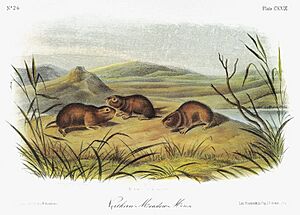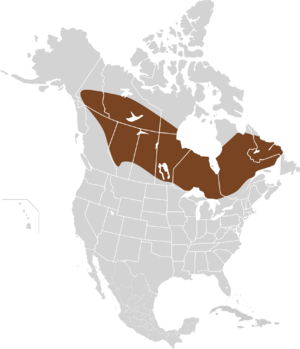Eastern heather vole facts for kids
Quick facts for kids Eastern heather vole |
|
|---|---|
 |
|
| Conservation status | |
| Scientific classification | |
| Genus: |
Phenacomys
|
| Species: |
ungava
|
 |
|
| Synonyms | |
|
Phenacomys intermedius ungava |
|
The eastern heather vole (scientific name: Phenacomys ungava) is a small vole found in North America. For a long time, people thought it was the same animal as the western heather vole. It is also known as the Ungava vole.
Some studies say the eastern heather vole is "rare" or "uncommon." But other scientists have found that it can be quite common in certain places. Its numbers might even go up and down in cycles.
Contents
What Does an Eastern Heather Vole Look Like?
Eastern heather voles are small, even for voles. They measure about 11 to 15 centimeters (4.3 to 5.9 inches) from their nose to the tip of their tail. They weigh between 15 and 47 grams (0.5 to 1.7 ounces). They look a lot like the western heather vole. You can only tell them apart by small differences in their fur color and skull shape.
Their fur is long and soft. Their back and head are brownish with a bit of yellow. Their belly and feet are light gray. The fur on their rump and sides is a brighter, reddish-brown color. Adult voles have a more yellowish face and snout. This color stands out from the rest of their head and body.
Tail and Ears
The eastern heather vole has a short tail. It's about one-quarter of their total body length. The underside of the tail is lighter than the top. Their ears are very tiny. They are hard to see because of their long fur.
Special Features
Male voles have special scent glands on their sides. These glands can be up to 28 millimeters (1.1 inches) wide. Females have eight teats, which they use to feed their babies.
Where Do Eastern Heather Voles Live?
Eastern heather voles live across most of Canada. You can also find them in a few spots in the United States near the Great Lakes. Scientists have named four different types, or subspecies, of this vole. However, not everyone agrees on these types.
Vole Homes and Habitats
These voles mostly live in forests with pine and spruce trees. They like areas with lots of plants growing close to the ground. But you can also find them in rocky places, willow bushes, wet peat bogs, and even cold, semi-tundra areas. They might be hard to find in many places. But in some specific spots, there can be many of them.
How Do Eastern Heather Voles Live?
Eastern heather voles are herbivores. This means they only eat plants. In summer, they munch on plant leaves and berries, especially blueberries. In winter, they eat the bark, seeds, and buds from willows and other shrubs. They are one of the few animals that can eat the bark of a plant called sheep laurel. This plant is usually toxic to other animals. By eating it, they help recycle nutrients in nature.
Who Hunts the Vole?
Owls and hawks often hunt eastern heather voles. Other hunters include meat-eating mammals like weasels and martens. These voles are active all year round. They are mostly busy around dusk or at night.
Vole Nests and Burrows
In summer, eastern heather voles live in burrows underground. A burrow has one tunnel that leads to a nest. The nest is about 10 centimeters (3.9 inches) across. It's usually 20 to 25 centimeters (7.9 to 9.8 inches) below the ground. There's also a separate bathroom chamber. The nest is lined with grass or other plant material to make it cozy.
In winter, they build bigger nests above ground. These nests are made of leaves and twigs. The snow around them helps keep them safe and warm. Voles store food all year long. They put it near their burrow entrance, in cracks, or under rocks. This way, they always have something to eat later.
How Do Eastern Heather Voles Have Babies?
Eastern heather voles have babies from June to July. After being pregnant for 21 days, a mother vole gives birth to two to eight young. When they are born, the babies have no fur and cannot see.
Growing Up
- By day six, they start to grow fur.
- By day eight, they can crawl around.
- By day fourteen, their eyes open.
- They stop drinking their mother's milk by day seventeen.
However, they don't reach their full adult size until they are over three months old. Female voles can have their own babies when they are four to six weeks old. But males don't usually breed during their first summer.
Normally, a mother vole has only one group of babies each year. But in some places, she might have a second group in August. Eastern heather voles can live for up to four years.


